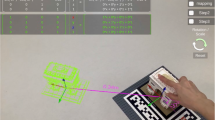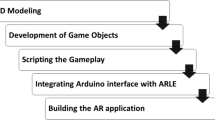Abstract
Student perception is an essential component in education; especially in engineering courses, which involve complex spatial processes, manipulation and interpretation of graphs, diagrams, and concepts. Incorporation of special training instructions improve spatial skills of learners, assisting them to acquire enhanced conceptual knowledge. Through this paper, concept validation of using immersive and interactive technology to attain better understanding of engineering fundamentals is presented. An Augmented Reality (AR) based Interactive Learning Environment (ILE) was developed for engineering undergraduates. Students were pre- and post-tested for technical knowledge through well-defined questionnaire and were administered different instructional treatments; viz. traditional teaching (control group) and ILE-based teaching (treatment group), for topics from control theory. Results of an empirical study indicate that students who were instructed through ILE scored more as they acquired similar perception through interactive visualization, thereby validating the use of AR for educational settings. By utilizing interactive 2D (2-dimensional) simulations, the research work ensures that 3D (3-dimensional) models developed to demonstrate theoretical topics using AR would also be feasible for implementation in classroom environments. The findings of this work instantiate a correlation between the role of interactive visualization and student’s learning for future studies.












Similar content being viewed by others
Data availability
The datasets generated during and/or analyzed during the current study are available from the corresponding author on reasonable request.
References
Andujar, J. M., Mejias, A., & Marquez, M. A. (August 2011). Augmented reality for the improvement of Remote Laboratories: An augmented Remote Laboratory. IEEE Transactions on Education, 54(3), 492–500.
Azuma, R. (1997). “A Survey of Augmented Reality”, Presence: Teleoperators and Virtual Environments, Vol. 6, pp 355–385, August.
Backlund, P., & Hendrix, M. (2013). “Educational games - Are they worth the effort? A literature survey of the effectiveness of serious games” 5th International Conference on Games and Virtual Worlds for Serious Applications, VS-GAMES 10.1109/VS-GAMES.2013.6624226.
Barata, P. N. A., Ribeiro Filho, M., & Nunes, M. V. A. (2015). Consolidating learning in power systems: Virtual reality applied to the study of the operation of electric power transformers. IEEE Transactions on Education, 58(4), 255–261.
Borrero, A. M., & Marquez, J. A. (2012). A pilot study of the effectiveness of augmented reality to enhance the use of remote labs in electrical engineering education. Journal of science education and technology, 21(5), 540–557.
Bower, M., Howe, C., McCredie, N., Robinson, A., & Grover, D. (2014). Augmented reality in education–cases, places and potentials. Educational Media International, 5(1), 1–15.
Camba, J., & Contero, M. (2013). “Incorporating augmented reality content in Engineering Design Graphics materials”, IEEE Frontiers in Education Conference (FIE), Oklahoma, USA, pp 35–40, October.
Camba, J., Contero, M., & Harranz, G. S. (2014). “Desktop vs. Mobile: A Comparative Study of Augmented Reality Systems for Engineering Visualizations in Education”, IEEE Frontiers in Education Conference (FIE), Madrid, Spain, pp 1–8, October.
Caudell, T. P., & Mizell, D. W. (1992). “Augmented reality: An application of heads-up display technology to manual manufacturing processes”, IEEE Hawaii International Conference on Systems Sciences, Kauai, USA, pp. 659–669.
Cohen, J. (2013). Statistical power analysis for the behavioral sciences. Routledge.
Contero, M., Naya, F., Company, P., Saorin, J. L., & Conesa, J. (2005). Improving visualization skills in Engineering Education”, Computer Graphics in Education. Published by the IEEE Computer Society, 25(5), 24–31.
Diao, P. H., & Shih, N. J. (2019). Trends and research issues of augmented reality studies in architectural and civil engineering education—A review of academic journal publications. Applied Sciences, 9(9), 1–19.
Di Serio, A., Ibanez, M. B., & Kloos, C. D. (2013). Impact of an augmented reality system on students’ motivation for a visual art course. Computers & Education, 68, 586–596.
Gouws, F. E. (2007). Teaching and learning through multiple intelligences in the outcomes-based education classroom. Africa Education Review, 4(2), 60–74.
Gutierrez, M., & Fernandez, M. D. M. (2014). Applying augmented reality in Engineering Education to Improve Academic Performance & Student Motivation. International Journal of Engineering Education, 30(3), 1–11.
Gutierrez, M., Garcia Dominguaz, M., Gonzalez, C., Hernanparez, A., & Carrodeguas, C. (2013). Comparative analysis between training tools in spatial skills for engineering graphics students based on virtual reality, augmented reality and PDF3D technologies”, international conf. On virtual and augmented reality in Education, (Elsevier) available online at www. Procedia Computer Science Vol, 25, 360–363.
Gutierrez, M., Navarro, R. E., González, M. A., “Mixed reality for development of spatial skills of first-year engineering students”. Frontiers in Education, & Conference (2011). (FIE), USA, pp T2D-1, October.
Hedley, N. (2003). “Empirical evidence for advanced geographic visualization interface use”, Proceedings of the 21st International Cartographic Conference (ICC), Durban, South Africa. pp 383–393.
Ibanez, M. B., Di-Serio, A., Molina, D. V., & Kloos, C. D. (August 2015). Augmented reality-based simulators as Discovery Learning Tools: An empirical study. IEEE Transactions on Education, 58(3), 208–213.
Ibanez, M. B., & Kloos, C. D. (2018). Augmented reality for STEM learning: A systematic review. Computers & Education, 123, 109–123.
Kaur, D. P., Mantri, A., & Horan, B. (2018). A Framework utilizing augmented reality to enhance the teaching–learning experience of Linear Control Systems. IETE Journal of Research. https://doi.org/10.1080/03772063.2018.1532822.
Kaur, D. P., Mantri, A., & Horan, B. (2019). Design implications for adaptive augmented reality based interactive learning environment for improved concept comprehension in engineering paradigms. Interactive Learning Environments. https://doi.org/10.1080/10494820.2019.1674885.
Kaur, D. P., Mantri, A., & Horan, B. (2020). Enhancing Student Motivation with use of augmented reality for interactive learning in Engineering Education. Procedia Computer Science, 172, 881–885.
Keller, J. M. (1979). Motivation and instructional design: A theoretical perspective. Journal of Instructional Development, 2, 26–34.
Keller, J. M. (2009). Motivational design for learning and performance: The ARCS model approach. Springer Science & Business Media.
Kell, H. J., & Lubinski, D. (2013). Spatial ability: A neglected talent in Educational and Occupational settings. Roeper Review, 35, 219–230.
Kim, J., & Shim, J. (2022). Development of an AR-Based AI education app for non-majors. Ieee Access: Practical Innovations, Open Solutions, 10, 14149–14156.
Kosa, T., & Karakuş, F. (2017). The effects of computer-aided design software on engineering students’ spatial visualisation skills. European Journal of Engineering Education. https://doi.org/10.1080/03043797.2017.1370578.
Kozhevnikov, M., & Thornton, R. (2006). Real-time data display, spatial visualization ability, and learning force and motion concepts. Journal of Science Education and Technology, 15(1), 111–132.
Lohman, D. F. (1979). “Spatial Ability: Individual Differences in Speed and Level”, Technical Report No. 9, Stanford, CA: Aptitude Research Project, School of Education, Stanford University.
Mayer, R. (2001). Multimedia learning. Cambridge: Cambridge University Press.
Milgram, P., & Kishino, F. (1994). A taxonomy of mixed reality visual displays. IEICE TRANSACTIONS on Information and Systems, 77(12), 1321–1329.
Noorasura, A. D., & Sazilah, S. (2011). “A model of mobile learning object design for concept comprehension using reciprocal teaching strategies and augmented reality”, In Computer Science and Automation Engineering (CSAE), 2011 IEEE International Conference, China. Vol. 3, pp 717–720, June.
Opris, I., Costinas, S., Ionescu, C. S., & Gogoase Nistoran, D. E. (2018). Step-by‐step augmented reality in power engineering education. Computer Applications in Engineering Education, 26(5), 1590–1602.
Pathania, M., Mantri, A., Kaur, D. P., Singh, C. P., & Sharma, B. (2021). “A Chronological Literature Review of Different Augmented Reality Approaches in Education”, Technology, Knowledge and Learning, pp 1–18.
Salar, R., Arici, F., Caliklar, S., & Yilmaz, R. M. (2020). A model for augmented reality immersion experiences of University Students studying in Science Education. Journal of Science Education and Technology, 1–15. https://doi.org/10.1007/s10956-019-09810-x.
Santos, M. E. C., Chen, A., Taketomi, T., Goshiro Yamamoto, G., Miyazaki, J., & Kato, H., “Augmented reality learning Experiences: Survey of Prototype Design and Evaluation”, IEEE Transactions on Learning Technologies, Vol. 7, No. 1, pp 38–56, January-March 2014.
Santos, M. E. C., Polvi, J., Taketomi, T., Yamamoto, G., Sandor, C., & Kato, H. (2015). Toward standard usability questionnaires for handheld augmented reality. IEEE computer graphics and applications, 35(5), 66–75.
Santos, M. E. C., Taketomi, T., Sandor, C., Polvi, J., Yamamoto, G., & Kato, H. (2014b). “A usability scale for handheld augmented reality”. Proceedings of the 20th ACM Symposium on Virtual Reality Software and Technology (pp. 167–176), Edinburgh, Scotland.
Schneider, B., & Blikstein, P. (2018). “Tangible User Interfaces and Contrasting Cases as a Preparation for Future Learning”, Journal of Science, Education and Technology, Springer, Vol. 27, No. 4, pp 369–384.
Shelton, B. E. (2003). “How augmented reality helps students learn dynamic spatial relationships” (Doctoral dissertation) Retrieved from ProQuest Dissertations and Theses, UMI No. 3111130.
Shelton, B. E., & Hedley, N. R. (2002). “Using augmented reality for teaching earth-sun relationships to undergraduate geography students”, ART02 The First IEEE International Augmented Reality Toolkit Workshop, Germany.
Shirazi, A., & Behzadan, A. H., “Content delivery using augmented reality to Enhance Students’ performance in a Building Design and Assembly Project”, Advances in Engineering Education, ASEE, pp 1–24, Winter 2015.
Slijepcevic, N. (2013). “The Effect of Augmented Reality Treatment on Learning, Cognitive Load, and Spatial Visualization Abilities”, Theses and Dissertations–Curriculum and Instruction, Paper 4.
Smith, M. E. (2009). “The correlation between a pre-engineering student’s spatial ability and achievement in an electronics fundamentals course”, All Graduate Theses and Dissertations, Paper 254 Doctoral Dissertation, Utah State University, UT, 2009. Available at: https://digitalcommons.usu.edu/etd/254.
Smith, S. P., & Harrison, M. D. (2001). User centred design and implementation of virtual environments. International Journal of Human Computer Studies, 55(2), 109–114.
Starner, T., Leibe, B., Minnen, D., Westyn, T., Hurst, A., & Weeks, J. (2003). The perceptive workbench: Computer-vision-based gesture tracking, object tracking, and 3D reconstruction for augmented desks. Machine Vision and Applications, 14, 59–71.
Taber, K. S. (2018). The use of Cronbach’s alpha when developing and reporting research instruments in science education. Research in Science Education, 48(6), 1273–1296.
Wang, Z., Bai, X., Zhang, S., Billinghurst, M., He, W., Wang, Y., Han, D., Chen, G., & Li, J. (2021). “The role of user-centered AR instruction in improving novice spatial cognition in a high-precision procedural task”, Advanced Engineering Informatics 47 101250, https://doi.org/10.1016/j.aei.2021.101250, 2021.
Wenk, N., Penalver-Andres, J., Buetler, K. A., Nef, T., Muri, R. M., & MarchalCrespo, L. (2021). “Effect of immersive visualization technologies on cognitive load, motivation, usability, and embodiment”, Virtual Reality https://doi.org/10.1007/s10055-021-00565-8.
Acknowledgements
The authors would like to express thanks to all the teachers and students for participating in the study.
Funding
The authors have no relevant financial or non-financial interests to disclose.
Author information
Authors and Affiliations
Corresponding author
Ethics declarations
Conflict of interest
The authors declare that they have no conflict of interest.
Ethics approval and consent to participate
The Research does not involve clinical human and/or animal’s data.
Competing interests
The authors have no competing interests to declare that are relevant to the content of this article.
Additional information
Publisher’s Note
Springer Nature remains neutral with regard to jurisdictional claims in published maps and institutional affiliations.
Rights and permissions
Springer Nature or its licensor (e.g. a society or other partner) holds exclusive rights to this article under a publishing agreement with the author(s) or other rightsholder(s); author self-archiving of the accepted manuscript version of this article is solely governed by the terms of such publishing agreement and applicable law.
About this article
Cite this article
Kaur, D.P., Mantri, A. Augmented reality based interactive table-top environment for real-time visualization of control theory concepts: An empirical study. Educ Inf Technol 29, 5309–5330 (2024). https://doi.org/10.1007/s10639-023-12050-7
Received:
Accepted:
Published:
Issue Date:
DOI: https://doi.org/10.1007/s10639-023-12050-7




